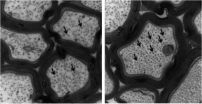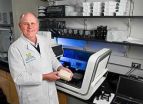(Press-News.org) RIVERSIDE, Calif. – A popular view among geophysicists is that large amounts of water are carried from the oceans to the deep mantle in "subduction zones," which are boundaries where the Earth's crustal plates converge, with one plate riding over the other.
But now geophysicists led by the University of California, Riverside's Harry Green, a distinguished professor of geology and geophysics, present results that contradict this view. They compare seismic and experimental evidence to argue that subducting slabs do not carry water deeper than about 400 kilometers.
"The importance of this work is two-fold," Green said. "Firstly, if deep slabs are dry, it implies that they are strong, a major current question in geophysics that has implications for plate tectonic models. Secondly, even small amounts of water greatly reduce the viscosity of rocks; if water is not cycled deep into Earth, it means that mantle convection has not been as vigorous over time as it would have been with significant water."
Study results appear in the current issue of Nature.
The Earth's lithosphere is formed at mid-ocean ridges where magma upwells and freezes to form new oceanic crust. Interaction between cold water of the deep ocean and the extreme heat of magma results in widespread cracking of rocks and a hydrothermal circulation that drives sea water several kilometers below the surface.
Away from the mid-ocean ridges, the lithosphere moves along under the ocean until it reaches an oceanic trench, long topographic depressions of the sea floor. Here, the lithosphere bends sharply and descends back into the mantle. Near the trench, numerous faults are created that provide a pathway for additional water to enter the down-going lithosphere. Subsequent dehydration results in large amounts of this water leaving the subducting slab and migrating upwards. The ensuing instability leads to seismic activity.
Geophysicists have long suspected but only recently established that at depths less than about 250 kilometers earthquakes occur through dehydration of minerals like serpentine. But when Green and his colleagues studied the data for deeper earthquakes, they found that the subducting slabs are essentially dry, providing no pathway for significant amounts of water to enter the Earth's lower mantle.
Further, the researchers cite evidence for olivine in the slabs at these depths, despite the fact that it is not stable below about 350 km.
"At these depths, olivine should transform to the stable phase, spinel," Green said. "The very cold temperatures deep in the downgoing slabs inhibit this transformation. Experiments show that even extremely small amounts of water, if present, would cause the olivine-to-spinel transformation to run. But we see no spinel here, just olivine, which confirms that the slabs are dry."
Green explained that the olivine found below 400 kilometers is "metastable," meaning it is physically present as a mineral phase even though this is not its "right phase" at such depths – akin to a diamond, which forms only at the kind of high temperatures and pressures found very deep in the Earth's crust, being brought to the Earth's surface.
"At such depths, the olivine should undergo a phase transformation," he said. "A different crystal structure should nucleate, grow and eat up the olivine. If it is very cold in the center of subducting slabs, the reaction won't run. This is exactly what is happening here."
According to Green, the presence of the metastable olivine provides an alternative mechanism to initiate deep earthquakes – a mechanism he discovered 20 years ago – and also to cause them to stop at around 680 kilometers, where they are seen to stop.
"Does this mean that Earth's deep interior must be dry? Not necessarily," he said. "It is possible there are other ways – let's call them back roads – for water to penetrate the lower mantle, but our work shows that the 'super highway,' the subducting slabs, as a means for water to enter the lower mantle can now be ruled out."
Green and his colleagues cite the evidence for the existence of metastable olivine west of and within the subducting Tonga slab in the South Pacific and also in three other subduction zones – the Mariannas, Izu-Bonin and Japan.
INFORMATION:
Green was joined in the study by seismologists Wang-Ping Chen of the University of Illinois, Urbana-Champaign; and Michael R. Brudzinski of Miami University, Ohio.
Grants from the National Science Foundation to the researchers supported the study.
The University of California, Riverside (www.ucr.edu) is a doctoral research university, a living laboratory for groundbreaking exploration of issues critical to Inland Southern California, the state and communities around the world. Reflecting California's diverse culture, UCR's enrollment of about 18,000 is expected to grow to 21,000 students by 2020. The campus is planning a medical school and has reached the heart of the Coachella Valley by way of the UCR Palm Desert Graduate Center. The campus has an annual statewide economic impact of more than $1 billion.
A broadcast studio with fiber cable to the AT&T Hollywood hub is available for live or taped interviews. To learn more, call (951) UCR-NEWS.
Geophysicists claim conventional understanding of Earth's deep water cycle needs revision
Commonly held view in geophysical community that water is carried deep into Earth's mantle is false, says UC Riverside's Harry Green
2010-10-19
ELSE PRESS RELEASES FROM THIS DATE:
No standard for the placebo?
2010-10-19
Much of medicine is based on what is considered the strongest possible evidence: The placebo-controlled trial. A paper published in the October 19 issue of Annals of Internal Medicine – entitled "What's In Placebos: Who Knows?" calls into question this foundation upon which much of medicine rests, by showing that there is no standard behind the standard – no standard for the placebo.
The thinking behind relying on placebo-controlled trials is this: to be sure a treatment itself is effective, one needs to compare people whose only difference is whether or not they are ...
NIH-funded scientists sequence genomes of lyme disease bacteria
2010-10-19
WHAT:
Scientists supported by the National Institutes of Health (NIH) have determined the complete genetic blueprints for 13 different strains of Borrelia burgdorferi, the bacteria that cause Lyme disease. The achievement should lead to a better understanding of how genetic variations among strains may result in different courses of illness in people with Lyme disease, the most common tickborne disease in North America. The wealth of new genetic data will also help scientists develop improved ways to diagnose, treat and prevent Lyme disease.
The first genome of a strain ...
Lastest graphene research could lead to improvements in bluetooth headsets and other devices
2010-10-19
RIVERSIDE, Calif. (www.ucr.edu) – Researchers at the UC Riverside Bourns College of Engineering have built and successfully tested an amplifier made from graphene that could lead to more efficient circuits in electronic chips, such as those used in Bluetooth headsets and toll collection devices in cars.
Graphene, a single-atom thick carbon crystal, was first isolated in 2004 by Andre Geim and Konstantin Novoselov, who won the Nobel Prize in physics this month for that work. Graphene has many extraordinary properties, including superior electrical and heat conductivity, ...
Optical technique reveals unnexpected complexity in mammalian olfactory coding
2010-10-19
Cold Spring Harbor, NY -- A team co-led by neuroscientists at Cold Spring Harbor Laboratory (CSHL) has shed light -- literally -- on circuitry underlying the olfactory system in mammals, giving us a new view of how that system may pull off some of its most amazing feats.
It has long been known from behavioral experiments that rodents, for instance, can tell the difference between two quite similar odors in a single sniff. But in such instances, what precisely happens in the "wiring" leading from sensory neurons in the nose to specialized cells in the olfactory bulb ...
Plastic monitors itself
2010-10-19
When the storm winds blow, wind turbines have to show what they can stand up to. The wind blows hard against mills with the force of tons as the tips of the blades plow through the air at more than 200 kilometers per hour. But natural forces not only tear at wind turbines; machine components made of plastic or airplane wings must with stand substantial loads as well.
These days, we normally use sensors to measure whether these components are strained beyond capacity, and it requires a lot of effort to install them into the component parts or glue them onto their surface. ...
Few nurse practitioners, physician assistants pursue careers in pediatric health
2010-10-19
ANN ARBOR, Mich. — Pediatric health care work force planning efforts are increasingly incorporating the roles of nurse practitioners and physician assistants, especially in plans to alleviate the perceived shortage of pediatric subspecialists.
However, results from four new studies of pediatric nurse practitioners, family nurse practitioners, neonatal nurse practitioners, and pediatric physician assistants published online today in the journal Pediatrics do not seem to support that idea. The work was conducted by the University of Michigan's Child Health Evaluation and ...
Penn study gives hope for new class of Alzheimer's disease drugs
2010-10-19
PHILADELPHIA – Finding a drug that can cross the blood-brain barrier is the bane of drug development for Alzheimer's disease and other neurological disorders of the brain. A new Penn study, published this week in the Journal of Neuroscience, has found and tested in an animal model of Alzheimer's disease a class of drug that is able to enter the brain, where it stabilizes degenerating neurons and improves memory and learning.
In the normal brain, the protein tau plays an important role in stabilizing structures called microtubules in nerve cells, which serve as tracks ...
ORNL theorist part of team that discovers unexpected magnetism
2010-10-19
OAK RIDGE, Tenn., Oct. 18, 2010 -- Theoretical work done at the Department of Energy's Oak Ridge National Laboratory has provided a key to understanding an unexpected magnetism between two dissimilar materials.
The results, published in Nature Communications, have special significance for the design of future electronic devices for computations and telecommunications, according to co-author Satoshi Okamoto of ORNL's Materials Science and Technology Division. The work was performed at Universidad Complutense de Madrid, synchrotron radiation facilities in France and Japan, ...
Four new psoriasis 'hotspots' identified by U-M geneticists
2010-10-19
ANN ARBOR, Mich. — Scientists at the University of Michigan Heath System and their collaborators have found four new DNA "hotspots" that may one day help guide new treatments for psoriasis, one of the most common autoimmune diseases in the country.
Using cutting-edge methods to peer into the hidden genetic underpinnings of the disabling and disfiguring disease, the research, published in Nature Genetics, further maps the as-yet unknown territories of psoriasis and psoriatic arthritis.
The findings could lead to new drug targets and tailored treatments for the skin ...
Japanese researchers report on liver transplantation studies using animal and iPS cells
2010-10-19
Tampa, Fla. (October 18, 2010) –Two research teams from the Okayama University Graduate School of Medicine (Okayama, Japan) have reported breakthrough studies in liver cell transplantation. One team found that the technical breakthrough in creating induced pluripotent stem cells (iPS) from mouse somatic cells (nonsex cells) in vitro had "implications for overcoming immunological rejection." Whereas a second team using liver cell xenotransplantation - transplanting cells of one species into another (in this case transplanting pig liver cells into mice) - found that transplanted ...
LAST 30 PRESS RELEASES:
For teens, any cannabis use may have impact on emotional health, academic performance
School meals could unlock major gains for human and planetary health
Menopause hormone therapy does not appear to impact dementia risk
Signature patterns of brain activity may help predict recovery from traumatic brain injury
Dresden study uncovers new key mechanism in cancer cells
New species are now being discovered faster than ever before, study suggests
Cannabis-based products show limited short-term benefit for chronic pain, with increased risk of adverse effects
Cannabis products with more THC slightly reduce pain but cause more side effects
Clearing the brain of aging cells could aid epilepsy and reduce seizures
Brain injuries linked with potential risk of suicide, new study finds
New technique lights up where drugs go in the body, cell by cell
New study finds movement of fishing fleets can reveal shifts in marine ecosystems
Embargoed: New evidence points to potential treatment for vascular dementia
Study uncovers disrupted brain balance in alcohol dependence
Working in groups can help Republicans and Democrats agree on controversial content moderation online
Structural findings reveal how distinct GPCR ligands create different levels of activation
Anything-goes “anyons” may be at the root of surprising quantum experiments
UC review: Maximizing workplace opportunity for veterans
From generation to complex control: Metasurfaces make perfect vortex beams "within reach"
Thin-film lithium niobate-based detector: recent advances and perspectives
Exploring why some people may tend to persistently make bad choices
How cells balance their protein levels
Nirsevimab vs RSVpreF vaccine for RSV–related hospitalization in newborns
Effectiveness and impact of maternal RSV immunization and nirsevimab on medically attended RSV in US children
AI gives scientists a boost, but at the cost of too many mediocre papers
Next-generation vision model maps tree growth at sub-meter precision
Genes aren’t destiny for inherited blindness, study shows
MIT study: High-fat diets make liver cells more likely to become cancerous
Exposure to multiple fine particulate matter components and incident depression in the US Medicare population
Risk of burdensome health care spending over time in the US
[Press-News.org] Geophysicists claim conventional understanding of Earth's deep water cycle needs revisionCommonly held view in geophysical community that water is carried deep into Earth's mantle is false, says UC Riverside's Harry Green



